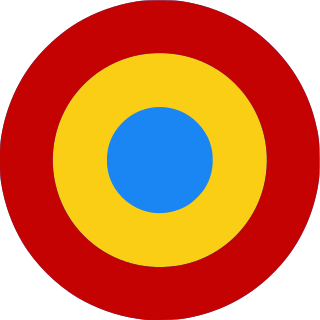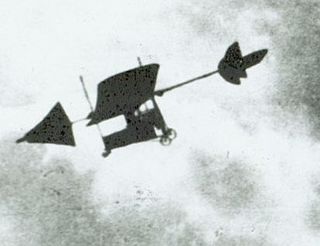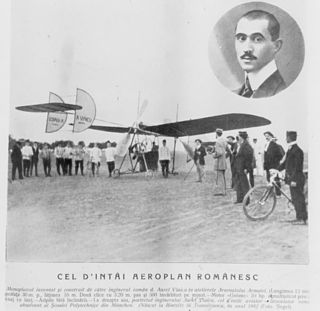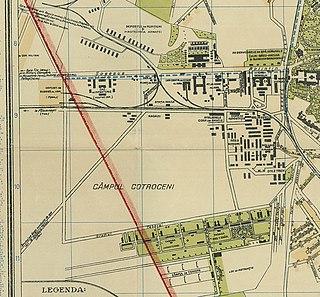
Aurel Vlaicu was a Romanian engineer, inventor, airplane constructor and early pilot.

Șerban Vodă Cemetery is the largest and most famous cemetery in Bucharest, Romania.

The Cygnet was an extremely unorthodox early Canadian aircraft, with a wall-like "wing" made up of 3,393 tetrahedral cells. It was a powered version of the Cygnet tetrahedral kite designed by Dr Alexander Graham Bell in 1907 and built by the newly founded Aerial Experiment Association.
Romania has a rich tradition in aviation. At the beginning of the 20th century, pioneers such as Henri Coandă, Aurel Vlaicu, Traian Vuia and George Valentin Bibescu made important contributions to early aviation history, building revolutionary aeroplanes and contributing to the international scene.

The Romanian Air Force (RoAF) (Romanian: Forțele Aeriene Române) is the air force branch of the Romanian Armed Forces. It has an air force headquarters, an operational command, five airbases and an air defense brigade. Reserve forces include one air base and three airfields.

Aurel Vlaicu International Airport is located in Băneasa district, Bucharest, Romania, 8.5 km (5.3 mi) north of the city center. Named after Aurel Vlaicu, a Romanian engineer, inventor, aeroplane constructor, and early pilot, it was Bucharest's only airport until 1969, when the Otopeni Airport was opened to civilian use.
The Bristol Biplane Type 'T', sometimes called the Challenger-Dickson Biplane, was a derivative of the Bristol Boxkite. It was built in 1911 by the British and Colonial Aeroplane Company and was designed as a cross-country racing aircraft for Maurice Tabuteau.

The SET 7 was a military trainer and reconnaissance aircraft that was produced in Romania in the mid-1930s. It was originally designed as a conventional single-bay biplane, with slightly staggered wings, a standard undercarriage with fixed tailskid, and a tandem open-cockpit arrangement for the pilot and instructor or observer. Power was supplied by an Armstrong Siddeley Jaguar radial engine, and from the outset the aircraft was equipped for wireless and photographic reconnaissance duties.

The ICAR 36 / ICAR Comercial (sic), variously also known as the ICAR M 36, Messerschmitt M 36 or BFW M.36, was a Messerschmitt design built and tested by the Romanian company ICAR in the mid-1930s. It was a small, single-engine high-wing airliner, the first civil transport aircraft built in Romania.

The ICAR Universal was a 1930s Romanian two seat monoplane trainer, touring and aerobatics aircraft.

The IAR CV 11 was a Romanian fighter prototype in 1930, designed by Elie Carafoli, and it was IAR's first original aircraft.

Gheorghe Caranda was a Romanian army officer and early aviator. He registered at Cotroceni Piloting School founded by George Valentin Bibescu in 1911, and earned his pilot license in 1912.

The Romanian Air Corps or Aviation Corps (RAC) was the air arm of the Romanian army until the formation of the Romanian Air Force. It was established on 1 April 1913 as the Military Aeronautics Service and subordinated to the Engineer Inspectorate, being organized in two branches – the aviation and the balloon branch. On 23 August 1915, the RAC was formed as an independent military arm and operated until 1 January 1924 when it became an equal to the Army and Navy, being redesignated as the Royal Romanian Air Force.

The A Vlaicu II was the second powered airplane designed and built by Aurel Vlaicu.

The A Vlaicu I was the first powered airplane built by Aurel Vlaicu.
During World War I, the Kingdom of Romania was a source of various types of military equipment. Either directly, or indirectly through Romanian-born people designing military equipment abroad.

The IAR-814, aka MR-2, was a Romanian designed and built twin-engined trainer aircraft built in the early 1950s, the first twin-eninged aircraft wholly designed and built in Romania.

Arsenalul Aeronautic in Bucharest was the first factory with an aeronautical profile in Romania. Its activity took place between 1919 and 1939. Arsenalul Aeronautic manufactured three models of aircraft: Hansa-Brandenburg C.I, Proto 1 and Aeron and modified De Havilland aircraft for passenger and freight transport. Also, at the Aeronautical Arsenal, research in the field of study and testing of materials was organized.

Proto 1 was a training biplane designed by Major Ștefan Protopopescu in collaboration with Dumitru Baziliu and Gheorghe Ticău at Arsenalul Aeronautic in Bucharest in 1922. It was the first Romanian airplane to be built in a specialized enterprise.



















